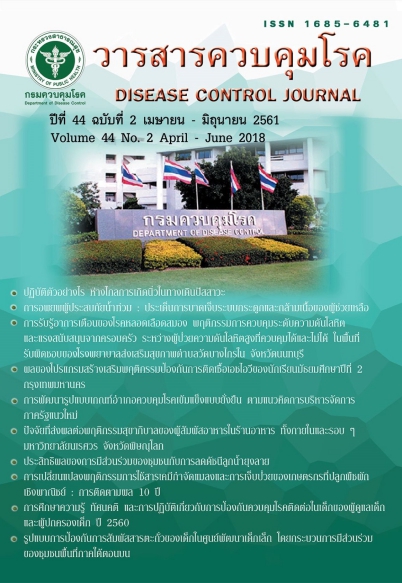Stroke warning signs perception, self-care behaviors and family support between controlled and uncontrolled hypertensions in the responsible area of Bang Krai Nai Sub-District Health Promoting Hospital, Nonthaburi Province
DOI:
https://doi.org/10.14456/dcj.2018.13Keywords:
perception of stroke warning signs, blood pressure controlled behaviors, family support, hypertensionsAbstract
The present study was aimed to compare the perception of stroke warning signs, blood pressure behavior and family support among controlled and uncontrolled hypertensive patients in the responsible area of Bang Krai Nai Sub-District Health Promoting Hospital, Nonthaburi Province. 230 simples who were diagnosed hypertension at least one year were collected from June 2016 to May 2017. Only 210 questionnaires were collected. The instruments used in data collection included demographic data form, perception of stroke warning signs, blood pressure controlled behavior and family support. Cronbach’s alpha correlation coefficient analyses revealed that the reliability of the instrument was 0.89. Data were analyzed using descriptive statistics and t-test. The study findings showed that the controlled and uncontrolled hypertensive groups had high and moderate level of perception of stroke warning signs ( = 3.50, SD = 1.28;
= 3.26, SD = 1.13), respectively, both of them had lowest level of diet-risk behavior (
= 1.22, SD = 0.28;
= 1.37, SD = 0.33, respectively), had moderate and low level of exercise behavior (
= 2.79, SD = 1.22;
= 2.28, SD = 0.97), respectively, had high and moderate level in stress management behavior (
= 3.75, SD = 0.72;
= 3.49, SD = 0.70), respectively, both of them had high level of drug-intake behavior and medical follow-up (
= 4.11, SD = 0.58;
= 3.96, SD = 0.58, respectively) and had high and moderate level in family support (
= 3.63, SD = 1.61;
= 3.32, SD = 1.24), respectively. Furthermore, the findings revealed that the perception of stroke warning signs, drug-intake behavior and medical follow-up and family support were not significantly different from the uncontrolled group at 0.05 (p = 0.158, 0.066 and 0.060, respectively). While the diet-risk behavior, exercised behavior and stress management behavior in controlled group were significantly different from the uncontrolled group at 0.05 (p = 0.000, 0.014 and 0.007, respectively). Thus, health personnel should continuously motivate the hypertensive patients to have proper diet-behavior, exercise behavior and stress management, especially in uncontrolled hypertensive patients.
Downloads
References
2. กระทรวงสาธารณสุข. สถิติสาธารณสุข พ.ศ. 2558 [อินเทอร์เน็ต]. [สืบค้นเมื่อ 1 พ.ค. 2560]. แหล่งข้อมูล: https://bps.moph.go.th/new_bps/sites/default/files/health_statistic2558.pdf
3. กนิษฐา บุญธรรมเจริญ, วิโรจน์ ตั้งเจริญเสถียร. ภาระโรค : ปีสุขภาวะที่สูญเสียและอายุคาดเฉลี่ยของการมีสุขภาวะของประชากรไทย.วารสารวิชาการสาธารณสุข 2559;25:342-50.
4. วิชัย เอกพลากร, หทัยชนก พรรคเจริญ, กนิษฐา ไทยกล้า, วราภรณ์ เสถียรนพเก้า. การสำรวจสุขภาพของประชาชนไทย โดยการตรวจร่างกาย ครั้งที่ 5 พ.ศ. 2557 [อินเทอร์เน็ต]. [สืบค้นเมื่อ 1 พ.ค. 2560]. แหล่งข้อมูล: https://www.hsri.or.th/researcher/research/new-release/detail/7711
5. Faul F, Erdfelder E, Lang AG, Buchner A. G*Power 3: a flexible statistical power analysis program for the social, behavioral, and biomedical sciences. Behavior Research Method 2007;39:175-91.
6. Goldstein LB, Silberberg M, McMiller Y, Yaggy SD. Stroke-related knowledge among uninsured Latino immigrants in Durham Country, North Carolina. J Stroke Cerebrovasc Dis 2009;18:229-31.
7. Das K, Mondal GP, Dutta AK, Mukherjee B. Awareness of warning symptoms and risk factors of stroke in the general population and in survivors stroke. J Clin Neurosci 2007;1412-6.
8. กานต์ธิชา กำแพงแก้ว, วิไลพรรณ สมบุญตนน์ม, วีนัส ลีฬหกุล. ความสัมพันธ์ระหว่างการรับรู้ปัจจัยเสี่ยง การรับรู้อาการเตือนและพฤติกรรมการดูแลตนเองเพื่อป้องกันโรคหลอดเลือดสมองในผู้สูงอายุกลุ่มเสี่ยง. วารสารพยาบาลกระทรวงสาธารณสุข 2558;2:40-56.
9. สุมาพร สุจำนงค์, มณีรัตน์ ธีระวิวัฒน์, นิรัตน์ อิมามี. ปัจจัยที่มีความสัมพันธ์กับการจัดการตนเองของผู้ป่วยความดันโลหิตสูง โรงพยาบาลส่งเสริมสุขภาพตำบลตลาดขวัญ จังหวัดนนทบุรี. วารสารวิทยาลัยพยาบาลบรมราชชนนี กรุงเทพ 2556;2:20-30.
10. กิรณา อรุนแสงสด, วันทนา มณีศรีวงศ์กูล, อรสา พันธ์ภักดี. ผลของโปรแกรมการสัมภาษณ์เพื่อเสริมสร้างแรงจูงใจแบบสั้นต่อความรู้ แรงจูงใจ และความต่อเนื่องสม่ำเสมอในการรับประทานยาของผู้ป่วยโรคความดันโลหิตสูง. วารสารพยาบาลสาธารณสุข 2557;28:129-44.
11. สุภาพร พูลเพิ่ม. ปัจจัยที่ส่งผลต่อพฤติกรรมการดูแลตนเองของผู้ป่วยโรคความดันโลหิตสูงในเขตอำเภอขี้เหล็ก อำเภอเมือง จังหวัดอุบลราชธานี. วารสารวิทยาลัยนครรราชสีมา 2555;5:49-54.
12. Chobanian AV, Bakirs GL, Black HR, Cushman WC, Green LA, Izzo JL Jr, et al. The seventh report of the Joint National Committee on Prevention, Detection, Evaluation, and Treatment of High blood pressure: the JNC 7 report. JAMA 2003;289:2560-72.
13. American Heart Association and American Stroke Association. Understanding and managing high blood pressure [Internet]. 2017 [cited 2017 Jul 20]. Available from:
https://dhhs.ne.gov/publichealth/WMHealth/Documents/Understanding_Managing_HBP.pdf
14. วิมุตชพรรณ ไชยชนะ, หทัยรัตน์ นิยมาศ. พฤติกรรมการดูแลตนเองของผู้ป่วยโรคความดันโลหิตสูง ชุมชนบ้านแม่พุง อำเภอป่าแดด จังหวัดเชียงราย. วารสารวิจัยระบบสาธารณสุข. 2550;1:92-8.
15. ณิชารีย์ ใจคำวัง. พฤติกรรมเสี่ยงของกลุ่มเสี่ยงโรคเบาหวานและโรคความดันโลหิตสูง : กรณีศึกษาโรงพยาบาลส่งเสริมสุขภาพตำบลบ้านปากคะยาง จังหวัดสุโขทัย. วารสารการพัฒนาชุมชนและคุณภาพชีวิต 2558;3:173-84.
16. อรทัย ชูเมือง, ศิริรัตน์ ปานอุทัย, ทศพร คำผลศิริ. ผลของการออกกำลังกายแบบโนราแขกต่อความดันโลหิตในผู้สูงอายุที่เป็นโรคความดันโลหิตสูง. วารสารพยาบาลสาร 2556;40:11-22.
17. จักรพันธ์ ชัยพรหมประสิทธิ์. โรคความดันโลหิตสูง. ใน: วิทยา ศรีดามา บรรณาธิการ. ตำราอายุรศาสตร์ 4. พิมพ์ครั้งที่ 3. กรุงเทพมหานคร: จุฬาลงกรณ์มหาวิทยาลัย; 2550. หน้า 176-99.
Downloads
Published
How to Cite
Issue
Section
License
Articles published in the Disease Control Journal are considered as academic work, research or analysis of the personal opinion of the authors, not the opinion of the Thailand Department of Disease Control or editorial team. The authors must be responsible for their articles.






